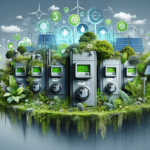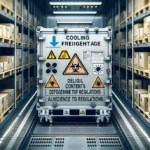Optimizing Your Data Center for Maximum Efficiency
In today's technology-driven world, a data center (DC) is the backbone of any organization's IT infrastructure. It houses critical servers, storage devices, networking equipment, and other mission-critical systems. However, with the increasing demand for data processing and storage, DCs are becoming more complex and energy-hungry. The result? Skyrocketing power consumption, rising energy costs, and an adverse impact on the environment. That's why organizations need to optimize their DCs for maximum efficiency to reduce power consumption, lower operating costs, and improve environmental sustainability. Here's how you can do it:
Understanding the Importance of DC Efficiency
Before diving into the strategies for optimizing your DC, it's essential to understand why DC efficiency is so critical. An energy-efficient DC helps save money by consuming less power, which is particularly important since DCs are estimated to consume around 3% of the world's total electricity [source]. Reducing your DC's power consumption can lower energy bills and promote environmental sustainability.
Moreover, an efficient DC reduces the risk of system downtime and improves overall reliability, which is essential for business continuity. Enhanced efficiency can also lead to better performance of your IT infrastructure, allowing your DC to handle more workloads and process data faster. This is crucial for businesses that rely heavily on their IT systems to operate.
Additionally, optimizing for efficiency now helps future-proof your infrastructure. As technology continues to evolve, the demands on your DC will only increase. By implementing efficiency measures today, you can ensure your DC is better equipped to handle future demands and avoid costly upgrades down the line.
Key Factors Affecting DC Efficiency
To optimize your DC effectively, you must first identify the factors that impact its efficiency. Here are some essential factors:
- Power Usage Effectiveness (PUE)
- Cooling Efficiency
- Equipment Utilization Rates
- Cabinet and Rack Configurations
- Energy-Efficient Technologies
- Renewable Energy Sources
- Data Center Location
Power Usage Effectiveness (PUE)
PUE is a critical metric that measures the ratio of total energy consumed by the DC to the energy consumed by the IT equipment alone. The ideal PUE value is 1.0, indicating perfect efficiency, but most DCs typically achieve a score between 1.5 and 2.0. A lower PUE score signifies higher efficiency. Improving PUE can lead to significant energy savings and reduced operational costs [learn more].
Cooling Efficiency
The cooling infrastructure in your DC is responsible for maintaining optimal temperatures for your IT equipment. An efficient cooling system ensures that equipment operates within recommended temperatures, reducing the risk of system failures and extending the lifespan of hardware. Advanced cooling techniques such as free cooling, liquid cooling, and hot/cold aisle containment can enhance cooling efficiency.
Equipment Utilization Rates
Ensuring that DC equipment, including servers, storage, and networking devices, operates at optimal utilization rates is crucial for maximum efficiency. Underutilized equipment can consume idle power, leading to energy waste and decreased overall efficiency. Implementing strategies like server virtualization and workload balancing can improve utilization rates.
Cabinet and Rack Configurations
The organization and configuration of DC equipment within cabinets and racks significantly impact efficiency. Poor rack airflow management can create hot and cold spots, increasing cooling costs and reducing overall efficiency. Proper cable management, equipment spacing, and airflow optimization are essential for maintaining an efficient DC environment.
Energy-Efficient Technologies
Implementing energy-efficient technologies such as virtualization, power management tools, and high-efficiency power supplies can significantly reduce power consumption and optimize DC efficiency. These technologies not only lower energy usage but also enhance the performance and reliability of DC operations.
Renewable Energy Sources
Incorporating renewable energy sources like solar or wind power can substantially reduce the carbon footprint of your DC and increase its efficiency. Renewable energy options are becoming more accessible and cost-effective, making them a viable choice for many organizations aiming to achieve sustainability goals.
Data Center Location
The geographic location of your DC can influence its efficiency. Selecting a location with a cooler climate can reduce the need for extensive cooling systems, thereby lowering energy consumption. Additionally, proximity to renewable energy sources and being closer to end-users can decrease latency and improve overall performance.
Designing Your DC for Optimal Efficiency
Designing your DC with efficiency in mind from the outset is crucial. Here are some best practices:
- Modular Designs: Utilize modular designs that allow for scalability and flexibility, enabling you to add or remove components as needed without significant overhauls.
- High-Density Equipment: Employ high-density equipment configurations to maximize space utilization and minimize energy consumption.
- Advanced Cooling Solutions: Implement advanced cooling and airflow management systems to enhance cooling efficiency and reduce energy waste.
- Energy-Efficient Hardware: Choose energy-efficient servers, storage devices, and networking equipment to lower overall power usage.
Implementing Energy-Efficient Technologies in Your DC
Introducing energy-efficient technologies is one of the simplest and most effective ways to optimize your DC's efficiency. Here are some technologies to consider:
Virtualization
Virtualization allows you to consolidate multiple servers onto a single machine, thereby reducing energy consumption and optimizing resource utilization. This approach can lower your PUE score, reduce hardware costs, and enhance your DC's overall efficiency.
Power Management Tools
Power management tools enable you to monitor your DC's power consumption, identify areas of high energy use, and implement power-saving measures. These tools can schedule power on/off times, reduce idle power consumption, and optimize overall efficiency.
High-Efficiency Power Supplies
High-efficiency power supplies minimize power waste and significantly improve your DC's efficiency. By using power supplies with higher efficiency ratings, you can lower your PUE score, reduce energy costs, and support environmental sustainability.
Monitoring and Analyzing DC Performance Metrics
Continuous monitoring and analysis of your DC's performance metrics are essential for maintaining and improving efficiency. Key metrics to monitor include:
Energy Consumption
Tracking your DC's energy consumption helps identify areas with high energy use. Utilizing energy monitoring tools allows for real-time tracking, enabling prompt adjustments to optimize energy usage.
Cooling Efficiency Metrics
Monitoring cooling-related metrics such as temperature, humidity, and airflow is vital for ensuring efficient cooling operations. Effective monitoring helps identify inefficiencies and areas needing optimization to maintain optimal cooling performance.
Equipment Utilization Rates
Monitoring the utilization rates of your DC equipment can uncover underutilized resources. By optimizing CPU, memory, and other resource usage, you can enhance overall DC performance and efficiency.
Strategies for Reducing Power Consumption in Your DC
Reducing power consumption is a fundamental step in optimizing your DC's efficiency. Here are effective strategies to achieve this:
Voltage Regulation
Regulating the voltage levels of your DC's IT infrastructure to match required levels can reduce power consumption, save energy, and enhance DC efficiency.
Power Capping
Power capping involves setting limits on the maximum power consumption of DC equipment. This strategy helps prevent energy waste by ensuring that devices do not exceed their power usage thresholds.
Consolidation and Decommissioning
Consolidating underutilized equipment onto fewer machines and decommissioning outdated or obsolete hardware can significantly reduce your DC's energy consumption and improve efficiency.
Importance of Proper Cooling and Airflow Management in Your DC
Effective cooling and airflow management are critical to maintaining DC efficiency. Proper management reduces the risk of equipment failure and minimizes energy waste. Here are key practices:
Cooling Infrastructure Optimization
Enhance your cooling infrastructure by installing high-efficiency cooling equipment, sealing air leaks, and implementing hot and cold aisle containment. These measures can significantly boost cooling efficiency and reduce energy consumption.
Airflow Management Optimization
Ensure that cooling airflows are directed appropriately to your equipment. Sealing air leaks and improving airflow distribution across your DC can prevent hot spots and enhance overall efficiency.
Best Practices for Organizing Equipment in Your DC
Organizing your DC equipment effectively is essential for optimizing efficiency and reducing power consumption. Follow these best practices:
Equipment Placement Optimization
Strategically place and orient your equipment to improve airflow and minimize hot and cold spots. Arrange equipment to reduce cable clutter and optimize power and data flow, enhancing both efficiency and performance.
Equipment Maintenance Optimization
Regular maintenance of your equipment, including cleaning, replacing worn-out parts, and performing software updates, can improve reliability, reduce power consumption, and maintain optimal efficiency.
Improving Server Utilization Rates to Maximize Efficiency
Your server infrastructure is a significant power consumer in your DC. Maximizing server utilization rates can effectively reduce energy consumption and optimize efficiency. Here’s how:
Virtualization for Server Consolidation
By consolidating multiple applications, workloads, and servers onto a single machine through virtualization, you can improve resource utilization rates, reduce power consumption, and enhance your DC's efficiency.
Load Balancing
Implementing load balancing ensures that workloads are distributed evenly across servers, reducing the risk of resource bottlenecks and optimizing server utilization rates and efficiency.
Training Staff on Best Practices for Energy Conservation
Ensuring your DC staff is trained on best practices for energy conservation and DC efficiency is vital. Staff should understand the importance of DC efficiency, identify areas of inefficiency, and implement measures to improve efficiency. Training also helps ensure compliance with regulatory frameworks and fosters a culture of environmental sustainability within your organization.
Optimizing Data Center Operations through Automation
Consider leveraging automation to optimize your DC operations. Automating routine tasks such as equipment monitoring, energy optimization, and performance monitoring can reduce errors, enhance efficiency, and optimize both operations and energy consumption.
Evaluating the ROI of Investing in Energy-Efficient Upgrades
Investing in energy-efficient upgrades can significantly improve your DC's efficiency, reduce energy consumption, and optimize power usage. However, it's essential to evaluate the return on investment (ROI) to ensure that the benefits outweigh the costs. Conducting a thorough ROI analysis can help you make informed decisions and prioritize investments that offer the greatest long-term savings.
Staying Ahead of Industry Trends and Standards to Maintain Efficient Operations
To maintain efficient DC operations, stay informed about the latest industry trends and standards. The technology landscape is continually evolving, and keeping pace with the latest advancements, best practices, and regulatory changes is crucial for maintaining competitiveness and optimizing DC efficiency.
Case Studies: Real-Life Examples of Companies Successfully Optimizing Their DCs for Maximum Efficiency
Several companies have successfully optimized their DCs for maximum efficiency, reducing energy consumption and promoting environmental sustainability. Here are some notable examples:
Microsoft's Dublin Data Center
Microsoft's Dublin DC stands out as one of the most efficient DCs globally, achieving an impressive PUE score of 1.07. This achievement was realized through innovative cooling techniques, advanced automation, and the deployment of energy-efficient equipment [read more].
Google's Efficient Data Centers
Google's data centers are renowned for their efficiency, with some facilities powered entirely by renewable energy and achieving PUE scores as low as 1.12. Google optimized its cooling infrastructure, introduced energy-efficient equipment, and invested in renewable energy sources such as wind and solar to attain these impressive metrics [learn more].
Apple's Maiden Data Center
Apple's Maiden DC is recognized as one of the world's most energy-efficient data centers, achieving a PUE score of 1.14. Apple enhanced its power efficiency by utilizing renewable energy sources, investing in energy-efficient cooling systems, and incorporating sustainable environmental features like a solar farm and fuel cell system [details here].
Conclusion
Optimizing your DC for maximum efficiency is vital for reducing energy consumption, lowering operating costs, and promoting environmental sustainability. By addressing the key factors that impact DC efficiency, implementing energy-efficient technologies, monitoring performance metrics, and adopting best practices, you can significantly enhance your DC's efficiency. Additionally, evaluating the ROI of energy-efficient upgrades, staying ahead of industry trends and standards, and learning from successful case studies will help you maintain efficient operations and continue to optimize your DC's performance.






















